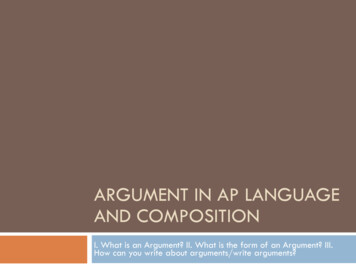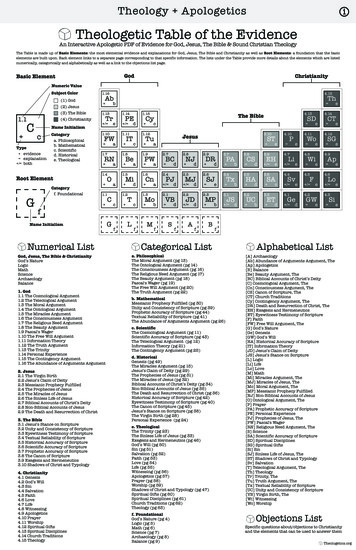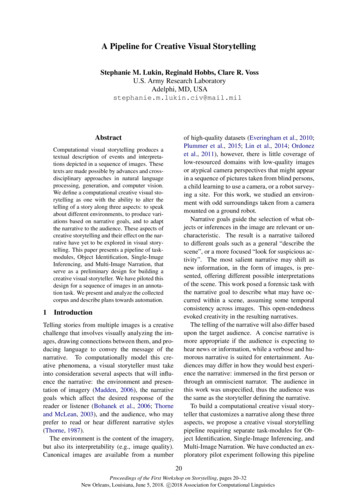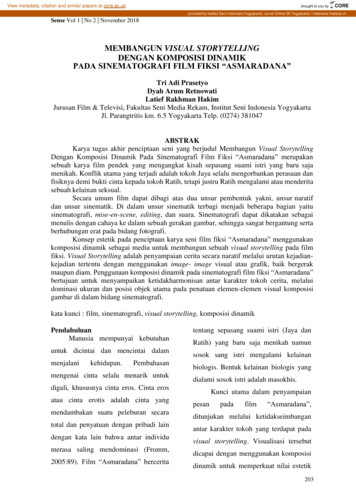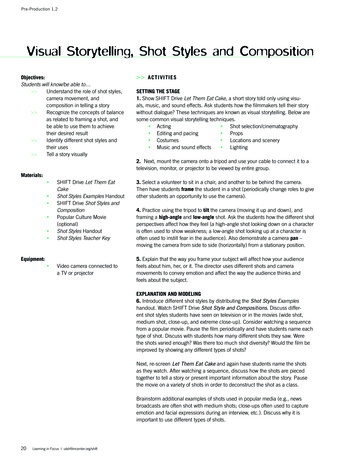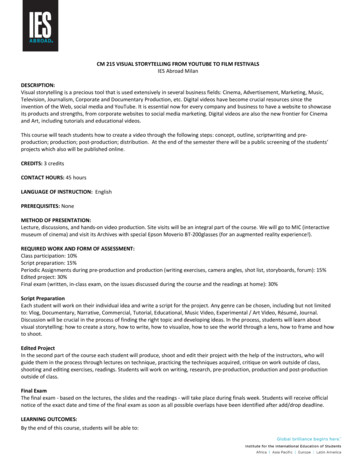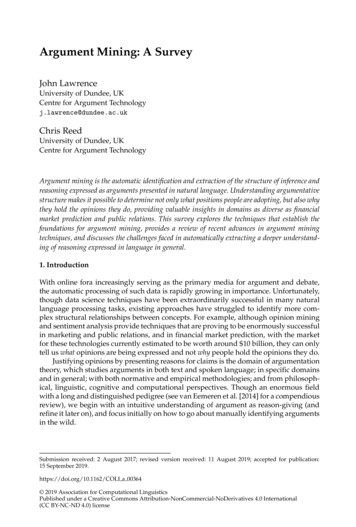
Transcription
Version 1.5C1
2
Contents1 Player Section1Character Creation . . . . . . . . . . . . . . . . . . . . . . . . . . . . . . . .2Character Development . . . . . . . . . . . . . . . . . . . . . . . . . . . . . .2 GM12345678SectionCharacter Creation . . . . . . . . . . .Character Development . . . . . . . . .Action Resolving . . . . . . . . . . . .Combat actions . . . . . . . . . . . . .Creating the story . . . . . . . . . . .Designing a setting and Setting specific6.1Races . . . . . . . . . . . . . .6.2Cybertech . . . . . . . . . . . .6.3Magic . . . . . . . . . . . . . .Argument and frustration . . . . . . .Acknowledgements & afterwords . . . . . . . . . . . . . . . . . . .rulings. . . . . . . . . . . . . . . .778111112131517191920202122A The Standard Fantasy Races23B Kalevala Magic27C Argument Vampires353
4
Argument DSSCopyright & Author infoWhat is a Storytelling System?c Copyright 2002 Rainer K. Koreasalo1“A storytelling system” is just another name(shades@surfnet.fi). All rights reserved.for a role-playing game system, used to emCopies of all or portions of Argument DSSphasise the fact that role-playing is supposedmay be made for your own use and for disto be about stories and having fun, not abouttribution to others, provided that you do nottables, charts and experience points.charge any fee for such copies, whether distributed in print or electronically.You may create derivative works such as Whatis Diceless roleadditional rules and game scenarios and supplements based on Argument DSS, provided playing?that such derivative works are for your ownDiceless role-playing is a role-playing genre ofuse or for distribution without charge, or forsystems that don’t use any random numberpublication in a magazine or other periodical.generators to determine the end results of aEvery derivate work must include the fol- particular action. This means no flipping thelowing “About Argument” section in it’s en- coin, rolling the dice or spinning the bottle totirety:determine i.e. how much damage a hit to thehead with a beer bottle does.There is a lot of commercial work onthis field of RPGs worth your time andmoney. The excellent “Amber - DicelessAbout Argument DSSRole-playing” from Phage Press is the pioneer and you might still get your hands onThis document uses the Argument Diceless “Theatrix” from Backstage Press. Others inStorytelling System by Rainer K. Koreasalo. clude “Persona” by Tesarta Industries, Inc.The argument system is a free diceless role- and “Epiphany” by BTRC.You might also want to read theplaying system, created to be distributed free”rec.games.frp.advocacy FAQ - part III”of charge on the internet.for some reflections on the subject. The naAll material using the Argument DSS is to ture of diceless role-playing is also describedbe distributed free of charge.in this document.The original, unaltered Argument DSS isavailable at the Argument DSS web site:The Argument systemhttp://people.cc.jyu.fi/ rakorea/argument/The Argument system comes in two parts.Chapter 1 is for players and contains all the1Except where a separate author is given, Copy- necessary rulings for character creation andright the respective authordevelopment. From that on the chapters deal5
with resolving actions and conflicts and howto be the GM with Argument. There are nosecrets in the GM sections — if a player wantsto understand how the system works he/shecan read those chapters too.Argument is designed to be diceless — butif the GM wishes the character creation process could be randomised to some degree. Argument is a storytelling system that is designed for generic environments; you easilycan play both fantasy and sci-fi with it. Iuse the industry standard abbreviations forthe usual role-playing terms. PC is a “playercharacter”, NPC is a “non player character”and the GM is of course “the game master.”Appendix submissionsThe Argument DSS distribution is open toadditions. If you wish to have your derivative work included in the main distribution ofArgument DSS as an appendix, contact theauthor.All writers who contribute an appendixwill retain the copyright over the submitted material but all material included will bepublished under the same license for furtherderivation. All writers will be duely credited.About this distributionThis document was typeset with LATEX, afreeware typesetting program for all platforms. PDF versions were produced with thebundled pdfLATEX software.The version number is composed of twoparts, the version number and the appendixletter. The version number 1.3B would translate as release 1.3 of the core document andB as the latest appendix. When a new release of the core chapters is written — usually with some additions or spelling fixes —the number increases. When a new appendixis added, the letter part changes.6
Chapter 1Player Section1You could be anything; a botanist, carsalesman, or in a fantasy setting — aknight.Character CreationRole-playing is based on the character.Your gaming experience is dependent onhow happy you are with your character. Nogame master can make the story flow rightor have interesting enough things happen toyou, when your character doesn’t feel right.With diceless role-playing we aim at greaterdepth of character.The first thing you need to do when creating a character for the Argument system, isto come up with the character concept andtalk about it with the game master. If theGM approves your choice of concept, try answering the following questions and then fillin the details.Make sure the rest of the choices youmake during this process reflect yourchoice of lifestyle. Motivation — What does your character want? What is the main driving forcein his life? What makes his clock tick? Curriculum Vitae (CV) - What hasyour character done?If you don’t start playing a newborn,your character is bound to have a past.Come up with both good things and badthings that have happened. Be creativeand don’t hold back - take enough timeto put some mass into this part. Name — Start with the name. It maydifficult if you’re not used to making upnames, but stick with it. Give your character a name. You get a certain wholeness to the picture when you can placeeverything in a named context.For a modern genre game you could evenwrite the actual CV for your character.Later, when you answer the questionsbelow, come back to this and see if itneeds additions or changes in light ofwhat you put down below.Names define us all, so the name comesfirst. Don’t give your character a comicalname if the setting isn’t comic. Love interests — Is your charactermarried? Occupation — What does this character do for a living? That’s the secondthing people ask a normal person, so thatshould come next.If not, is the character in love? Or is thecharacter perhaps living “la Vida Loca”?Maybe the character has homosexualtendencies or the character is a gay person.This is usually the defining part of character creation. In dice using games thisis usually done by selecting the character class. Think about this choice for amoment, don’t just put down “an adventurer”.Don’t hold back with this part of description either, love — or the lack of it — isa big part of our lives.7
Religious / Magical attitude — If tune it down if he thinks your character willthe GM’s setting is a magical one, what be too powerful.does your character think about magic?The Argument system data will look someIs the character perhaps a magic user? Ifthing like this:not, does he fear those who practice theJohn Doe is a human male. He hasarts?medium strength and good endurance.If the setting is religious one, or the His perception is good but his willpowerworld contains any religions at all, is the is pathetic.character a member of such churches?Note that there are four attributes in thedescription.A minimal CV skill descriptionIs he just a member or a devotee? Doesyour character even believe in that stuff for the character concept could look something like this:anyway? John is a mechanic of good abilities. Good / Bad attitude (stuff ) — Dodogs bark at your character? Are birdssinging when he walks in a forest, or dothey try to hit the character with theirfaeces? He’s a high-school graduate and an experienced driver. John has no criminal record, and he isgenerally a well-liked man.Is the world a good or a bad place to livein? Are you happy? Do you make othershappy too?Also note that can be quite difficult to distinguish between attributes and skills. Depending of the setting you are going to playin, the GM might give you more attributes— fortune for example is one of the optionalattributes. Your attributes define your character, if you have a particularly high or lowattribute, make that show on your characterdescription. Anything else? — By now you shouldunderstand why and how to answer thesequestions and build the background foryour character. The questions are hereto guide you write your character beyondsimply marking the colour of your eyeson the character sheet.But don’t stop here, think about thequestions and when the GM tells you2 Character Developmentsomething more about the setting youare going to play in, come up with yourCharacter development is the key to allcharacters opinions, manners, thoughtsdrama. In most games this is done by expeetc. about any particular subject.rience points etc. All you see in those gamesThe more you write down, the better.are rising percentages, hit points and all sortsof other numerical information. That is notWhen you’re done answering these ques- the kind of development that adds depth totions have another chat with the game mas- your character.Argument uses an intuitive system of CVter. The GM will tell you what your skillsand attributes are. Don’t expect long lists based skill tracking for your character’s develof skills and powers if you didn’t write about opment. It’s best I demonstrate to explain:them in the occupation, CV and Magic partof the character description. If you didn’tThe aforementioned John Doe gets a jobwrite when and where, how and why you as a limousine driver for a very respectablelearned something - you probably didn’t learn company. He spends four months as a driverit. Elaborate and be creative. The GM will for the C.E.O. of that company. John gains8
four months experience of operating limousine like motorcars. He also gains an insightin the company’s business habits at high levels, knows the names of the C.E.O’s familymembers and where they live.In short John’s skill list would now besomething like this: Medium grade High School Graduate. Good in Mechanics, Auto Good in Drive, Auto Expert in Drive, Large Limousine.Good knowledge in: The Named Company C.E.O. personalmatters — wife, children, mistress, etc. The Named Company Business Contacts. The Named Company Holdings, Buildings etc. Good reputation. Medium monetary credit rating.All the experience is hierarchically noted asnew specific skills and knowledge. This is allyou need to know as a player. The GM willprovide you with additional information.9
10
Chapter 2GM Section1Character CreationNormally a character is a set of attributesdescribed with cold numbers and a minimal description. But characters aren’t numbers. Argument uses adjectives to describethe character’s ability in the attributes andskills. The standard skill/attribute adjectivesare:in the neighbourhood, as an easygoing manwith not much restraint when it comes to alcohol. It’s safe to say that John has patheticwillpower.”There are a bunch of other attributes thatthe GM can plug in the system: Fortune Appearance Pathetic Dexterity Bad Intelligence Medium Good Excellent SuperiorThe attributes that Argument uses are Strength Endurance Perception WillpowerA typical human being would be hence described in Argument mechanics as follows:“John Doe is a man of middle height andmedium strength. His body is not unusually framed - no bulking muscles can be seen,but his posture tells of a man with good endurance who can run at least for some 15minutes. He has a solemn face and lively eyeswith good perception. John is well knownI’d advice to use the intelligence attributewith caution. Even good role-players tendto overplay that particular attribute. If thecharacter is unusually smart the GM will haveto take part in the role-playing of that character and if the character is a bit dim thatcan be problematic also. While playtestingthe intelligence was approximated from thecharacter background and the willpower attribute with great results. Raw intelligenceis rarely needed anyway, and Argument characters should have enough background to determine whether they have the keys to unlocka particular problem.Use your best judgement to tune the system to meet your needs. There are variousmethods of setting the attribute adjectives.The primary method for this is to have anextended talk with the player and discussthe character. The player’s character concept should give you a pretty good idea whathis/her attributes are.Pathetic or excellent and superior level attribute adjectives always come with a reason11
for the rank. Make sure you add the reason for such a high or low-level adjective tothe character description. Make the characterwith the high strength an Arnold-like muscleman and give the one with bad willpower alcoholism or some other similar disadvantage.Every large deviation from medium shouldhave a reason.If your players don’t have a clear pictureof their characters the attribute creation canbe quite difficult. In that case you can assign attribute adjectives by using an arbitraryrandom number generator to deviate the adjectives from “medium.” Here are a couple ofexamples:Get a deck of ordinary playing cards. If youdraw a black card the attribute goes down,with a red card the attribute goes up. Todetermine how much the attribute changes,draw an even number (GM discretion) ofcards for each attribute.Example: You’re creating the John Doecharacter. You’re determining his endurance,beginning with a medium rank. You drawsix cards from the deck. There’s 4 red and 2black, hence the attribute rises to reach goodendurance. If you’d drawn 4 black and 2 redthe attribute would have gone down to badendurance.If more than 2/3 of the cards drawn are ofone colour the attribute goes down 2 levels.colour present or not. Use your judgement togive each card a or - value to the attribute.Then calculate the total. The rule 2/3 for /-2 applies here too.Third option is to search the flavour text ofthe drawn CCG cards for adjectives. Be sureto browse through the deck before you assignattributes so you can normalise the variation.This is also a good idea for the colour searching option.Again, you can use any random numbergenerator you wish or can come up with. Tryhanging around in town and determine theattributes with how beautiful the women are.When using this option, if you don’t want tohave high-power campaign, stay out of Japan.When using the random attribute level system, I recommend that you let the playersraise one attribute below excellent level byone level. They should also be able to lowerattribute scores to gain a significant amountof CV content. I also recommend that youdraw the attribute scores and let the players define which adjective goes to which attribute.Bear in mind, that the randomised attribute adjective deviation systems given hereare an extension. Both the GM and Playershould always create the character as a combined effort. If you use the system describedabove, always remember - the randomnessstops here. The action resolving in dicelessstorytelling does not rely on drawing cardsfrom a deck. See section 3 for action resolving with the Argument system.Example: When assigning John’s willpowerattribute you draw six cards, five blacks andone red. This means that John’s willpowergoes down 2 levels — since 2/3 of 6 is 4 and5 is more — from medium, leaving him with 2Character Developmentpathetic willpower. A draw is a draw is adraw. With equal amount of red and black As described before in the Player section theArgument system uses a CV-based skill trackthe attribute is of medium level.ing system. The characters’ capabilities areThe second option for attribute determina- described with the standard adjectives givention is by using a collectible card game deck. in section 1.The character background you and thePick a colour at random, say — the colourgreen. Then draw cards like in the ordinary player write down determines the characplaying card example, one for each character ter’s initial skills. Try to standardise andfor each attribute. Now see if the artwork normalise the skill level adjectives for yourof those cards has a large quantity of that players’ characters. Try to make them well12
matched to avoid in-party fighting and biasaccusations. Don’t let one player start withsuperior skills if the others have good skillsat maximum.The character development system described in the player-chapter seems quite simple but isn’t. It is not easy to keep track ofall the things a PC does. Since there are noskill lists to tell what actions to track theGM must make some tough decisions. I’drecommend that at first you have the players keep detailed diaries of their characters’actions. Tell them not to keep track of everyshot fired or every lock picked, but rather toput down successful missions and what kindof skills they had to use to succeed. The goalhere is to keep track of the character’s abilities and his advancement, not to count thetimes he fixed a broken tire.If the character often gets an argument —described in section 3 — or manages to turn itinto a permanent argument and thus successfully performs actions over his normal capabilities in that field, that should give groundsfor permanent raise in his skill adjective level.An argument becomes permanent when thecharacter gradually learns the skill. This usually means that a new sub skill is added tothe character’s CV leaving the base skill levelunmodified. The base skill level rises only bygaining enough (GM discretion) sub skills tocover the whole field of that base skill.I don’t recommend using the same reasoning for attributes and skills. Attribute development should be a lot more difficult — if notimpossible — than skill development.you were heading at, but most of the times itjust ends up killing a couple of characters andcreating resentment in players. Of course youcan always ignore the die roll, but if you’regoing to do that — why roll it in the firstplace?The main concept of diceless action resolving is in the old saying, “let the best manwin.” It’s that simple. The character, PC orNPC, with the highest ability or skill alwaystakes the day, unless there’s an advantage —an argument — on the weaker side that levelsthe playingfield.In evenly matched situations the going getstough. Who’s the better man/woman whenthey’re equally skilled? That’s when the arguments come in play. An argument is in aword — an advantage.The advantage can come from physicalcharacteristic: in an evenly matched fistfightone of the characters has an elevated position,or he is a lot bigger than his adversary is.The argument can come with an equipmentor experience: in a manhunt the fugitive has agood hiding place and the service man searching for him is just a good seeker. The tie isbroken, because the police wield an infraredcamera that gives them a superior perception.A player can only get an argument by roleplaying. If the character does something thatgives the story just the right direction youwere wishing for you should think giving hima positive argument (special knowledge of thearea for example) or if the character doessomething extremely stupid (like they alwaysdo) give them a negative argument.A positive argument raises the appropriateskill or attribute for the task the argument ismeant for and a negative lowers it. Don’t let3 Action Resolvingyour players know you’re giving them negaAction resolving is the most difficult part of tive arguments if they’re not physical in nadiceless storytelling. In systems that use dice ture. Misinformation as a negative argumentthe action resolving is all about the die roll. is a most delicious plot device.The die determines if an action succeeds ornot. I think this is wrong.Example: John Doe is racing the limousineIn storytelling we aim at the story. It’s to get away from mercenaries that are tryingnot really all that much fun if the PCs fail at to kill his boss, the C.E.O. of Named Coma critical moment just because the dice roll pany, Inc.went badly. Sometimes that was just whatJohn is an expert limousine driver, as men13
tioned in the character development part.But, unfortunately the man driving for thebad guys is an expert van driver, hence Johnis unable to shake him.The chase continues into the commercialdistrict of the Named City Metropolitan area.John has good knowledge base of the NamedCompany holdings in this area. He makes adaring manoeuvre over three lanes and manages to cut into the Named Company parking hall where he gets on the second floor before the pursuers can follow. Meanwhile, theC.E.O. has used the car phone to call for security and the assailants are held at gunpointin the first floor.In the given example the argument for thedriving skill was the knowledge of the area.Knowing the location of the parking garagewas enough to boost John’s driving skill tosuperior. Note that the argument was usedto raise the driving skill level in comparisonto the adversary’s driving skill.If there is no direct or indirect opponentfrom whom to determine the skill level thePC’s skill is to be contested against, the GMmust give the attempted action a difficultyrating. Such a situation is called a noncontested action. Difficulty rating is simplythe adjective level the character must reachwith or without arguments to succeed in theaction.You can give the players continuous arguments for particular purposes. Such arguments can i.e. come from using specific equipment, or having knowledge of timed events,such as the time of the supposed triad hit tothe First Bank of Named City MetropolitanArea. Continuous arguments don’t count towards skill development if they are not madepermanent. See section 2 for argument permanency.Arguments never give an advantage overnormal skill level. Had the driver for the assault team been a superior driver he wouldhave been able to follow John’s manoeuvreinto the garage. When an argument is usedto boost or deteriorate a skill or an attributethe result is called an argument rank. The re-sulting argument rank is always weaker thana normal no-argument rank of the result level.When deteriorating a skill the argument rankis always stronger than a normal no-argumentrank of the result level.Some actions can’t have positive arguments. Such actions are said to be skill or attribute critical. For example, actions that fallwithin the medical profession are skill criticalin the worst-case scenario.Let’s assume the patient has suffered critical injury (injuries described in section 4) viagunshot wound to the stomach.A critical injury requires excellent levelskill in medical profession (surgery) to stabilise the patient. The closest skill equivalentthe PCs have is of a good field medic level.The player characters make an argument thatwith their extensive first aid kit they shouldbe able to stop the bleeding, and they areright - the bandages help to stop the bleeding but the bullet has ruptured the intestinesand the patient dies of infection in less thanan hour.Note that had the bullet hit the patient inthe arm or a leg the bag would have providedsufficient equipment to stop the bleeding.The skill or attribute critical actions are asmall minority of situations. Rules for whento call for skill critical actions cannot be givenunequivocally. It’s up to you, but here’s agood thumb rule: “Difficulty rating of excellent or superior in a non-contested action usually makes it a skill critical action.”If a player has no experience in the fieldof action he’s trying to commit, that actionis a considered unskilled. Unskilled actionsare considered skill critical pathetic level actions, unless they are clearly attribute-basedactions. Attribute based unskilled attemptsare considered as actions one level below theattribute adjective level and they’re also skillcritical.Let your players know when you invoke theskill critical actions. This will serve as anefficient mood creator ( see section 5.)14
4Combat actionsCombat is an essential part of some roleplaying settings and very few settings manage to be completely combat free. Combatcreates excitement and if well placed, phasedand balanced, it can make your story deeperand more captivating.It is often believed that diceless roleplaying can’t handle combat. This is ofcourse, wrong. Diceless storytelling can handle combat as well as any dice using system.It just takes a bit more effort.Combat is handled as a contest of skills.There is no real difference between resolvingthe driving example above and a fistfight inan alley - the best skill wins.Combat arguments often come from knowing or getting to know the weaknesses of youropponents. In combat, perception and combat awareness are the keys to survival. Always make combat dangerous and never leavea stupid action unpunished. Don’t be afraidto hurt the PC’s, but don’t overdo it. Be justand unbiased. Yes, I know - that’s a lot toask.The most difficult thing with diceless combat resolving is the need for detail. If theplayer doesn’t understand what is happening, and what threats are present, you can’texpect him/her to make all the right decisions you had in mind. You have to describethings thoroughly. Make a point of describing imminent death threats at least twice inyou description.Consider this combat example:. . . You’re standing there on the bridge asyou decided to leave behind and detain yourpursuers so that your buddies can carry thewounded professor back to the van.Player: Yeah. I stand somewhere in themiddle of the bridge and wait for them.Ok. There are five men in black businesssuits, white shirts and black sunglasses, realmen in black. They run from behind the corner and reach the bridge in ten or so secondsas your buddies have just reached the coverof the buildings. Then they just stop.Player: They stop?Yes. One of them raises his left hand andholds his middle finger against his ear. Heseems to be talking to his sleeve.Player: He’s calling for back up.Could be, or he’s requesting confirmationon something. What are you doing?Player: I draw my pistol and start takingbackward steps. I try to keep my eye on them.The man talking to his sleeve nods. Hisright hand goes under his left arm inside hisjacket. He nods again. What are you doing?Player: He’s reaching for his gun, I go forcover of one the bridge poles and start shooting.Wait a minute, how fast do you make themove for cover? With a leap or with a fewhasty steps?Player: I jump for cover, grouching behindthe pole.And you plan to shoot, yes? OK. Whenyou make a fast movement all the five mendraw their large handguns. When you hitthe ground behind the pole you hear the gunsthunder shots at you. Five shots rain aroundyou. Three of them hit the ground under youas you leap. Two ricochet out of the pole asyou land. You’re not hit but shooting fromthis position is out of the question. What areyou doing?Player: I meant, I try to squeeze a shotwhile I’m still in the air.You needed both of your hands near yourtorso to land somewhat safely. You’re not anexpert acrobat, you see, and the leap you justpulled off was quite a feat. Oh, by the way.Hitting the asphalt you took some minimalinjuries, so mark that down. What are youdoing?Player: How good is the cover?You can’t see them in this position, butwhether or not they can see you, you cannotsay. What are you doing?Player: I don’t need to see them to knowthat they’re probably moving to a safer position instead of standing there in the middle of the bridge. Since I can’t see them, Iwon’t waste my time and life on trying to firesome rounds just for the sound of it. I push15
up from the ground to get up on my feet andthen continue the movement to jump over therailing.Good reasoning. When you get of theground you hear three shots. You hear twoof them clang against the railing as your leaptakes off. You have to use a lot of strength,good thing you have more than enough withyour excellent level. Your jump is just a bitoff to the right and your legs hit the rail asyou go over it.Player: You said three shots and two to therailing, what happened to the other shot?As you fall the 15 meters from the bridgeyou feel a wave of pain from your right leg. Iguess that’s where the third shot landed andthat’s why your leap was a bit off. You landwith not quite so Olympic level dive to thewater. That was one long drop so you godeep into the water. What are you doing?.Try to describe the events from the viewpoint of the character. If the character haspresumptions describe things that way. Takespecial care of inserting the character’s viewon life to your description. Listen to the questions your players ask for such presumptionsand play by them. Try to make your playersspeculate and reason aloud so you can get abetter picture whether they are being stupidor not. Remember that one man’s wisdom isother man’s folly. Don’t punish sound reasoning, even if it’s wrong, but the lack of it.Learning to describe the environment tomeet your players’ needs is something thatwill take a while to learn. In dice using systems the GM can always hide behind the dieroll to provide the outcome, in diceless roleplaying you will really have to go on a limbto make the world alive and the threat real.Combat usually takes a significant amoun
the usual role-playing terms. PC is a “player character”, NPC is a “non player character” and the GM is of course “the game master.” Appendix submissions The Argument DSS distribution is open to additions. If you wish to have your deriva-tive work included in the main distribution of

